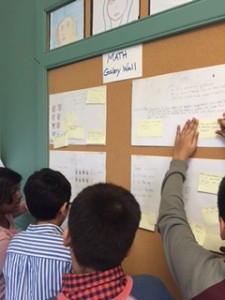These are the words that I chant as the end of the school year draws near in June. It is a challenging time, unlike the busy planning and organizing needed to set the pace in September. The days now feel longer and there seems less content to cover, as it was mostly completed in time for reporting. So, this may be a good time to review the concepts that your students struggled with throughout the year, or a time to introduce a topic related to the curriculum or their inquiry work that wasn’t in your long range plans. But filling in the days with worksheets and outdoor play is not the answer, it leads to issues of classroom managements and student discontent.
Here are some suggestions that can be adjusted for your age group or subject area:
- create math teams that solve math problems from all strands. Then have teams present their answers and compare their strategies. One word problem a day.
- provide time for student groups to create a summary of their literature circle book. They can present their summaries as a series of tableaux, a movie trailer on iMovie, or as a skit. These are presented to the whole class or another class to promote reading for the summer months.
- list 3 or 4 issues on the board and have students sign up accordingly. Provide them with a structure to research and present in a debate that you monitor (debates can be informal or formal)
- show students a youtube video on branding and logos. Then ask each student what their brand is. Have them design a logo (that doesn’t reveal their name). Display all logos with a number when completed and have students complete a numbered list, matching each logo to their classmates. Discuss the most effective logos and why.
- provide groups of 4 students with a bag of mixed materials to encourage STEM (Science, Technology, Engineering, Math) learning. Provide them with an hour each day to design and create a product with the recycled or mixed materials. Display and share in the last week of school for other classes.
- Read aloud. Students of all ages love to be read to. Pick a recent and relevant chapter book and read to your students each day. Have them draw character sketches, write 3 predictions, or create alternative cover for the book.
- Use large paper to ask about 5 reflective questions related to your year. Questions such as, What would you change in the past school year? How has your understanding about Mental Wellness changed? What projects did you find most meaningful to do? Then have students do a gallery walk and fill-in responses on the large paper. Display for the last week and highlight evidence of learning and understanding.
Enjoy the last weeks and keep the students engaged with the meaningful work they will value.




